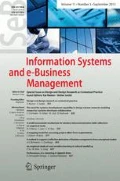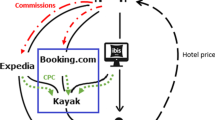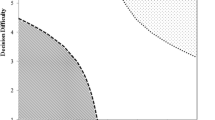Abstract
O2O (Online to Offline) on-demand service platforms have grown significantly. With the intensive competition on platforms, effective promotion strategies are the key to the success of O2O stores. Given the specific features of O2O platforms and mobile apps, how different promotions strategies work remain a question. The study investigates the effectiveness of different promotion strategies and their interactions on O2O platforms. Using daily sales data from a store on a well-known O2O platform, we construct a product-level panel with daily sales and promotion information. With fixed-effect regressions and GMM models, we find that both discount promotions including price discounts and order-level discounts and display-related promotions including display banners and rankings in lists can significantly increase product sales. We find that top rankings may be one of the most effective promotion strategies in O2O context. Seemingly organic rankings in lists is more effective than large store-page banners. We also find that direct price discounts perform better than order-level discounts for reaching a threshold. Price discounts and display-related strategies strongly complement each other to increase sales, while the impact of order-level discounts cannot be strengthened with display-related promotions. The findings reveal interesting patterns of how different promotion strategies affect sales and interact with each other and provide theoretical and practical implications.



Similar content being viewed by others
Notes
We focus on rankings of predefined lists of stores, not the search results.
References
Agarwal A, Hosanagar K, Smith MD (2011) Location, location, location: an analysis of profitability of position in online advertising markets. J Mark Res 48(6):1057–1073
Alvarez BA, Casielles RV (2005) Consumer evaluations of sales promotion: the effect on brand choice. Eur J Mark 39(1/2):54–70
Animesh A, Viswanathan S, Agarwal R (2011) Competing “creatively” in sponsored search markets: the effect of rank, differentiation strategy, and competition on performance. Inf Syst Res 22(1):153–169
Ashworth L, Darke PR, Schaller M (2005) No One wants to look cheap: trade-offs between social disincentives and the economic and psychological incentives to redeem coupons. J Consum Psychol 15(4):295–306
Braun M, Moe WW (2013) Online display advertising: modeling the effects of multiple creatives and individual impression histories. Mark Sci 32(5):753–767
Burtch G, Hong Y, Bapna R et al (2017) Stimulating online reviews by combining financial incentives and social norms. Manage Sci 64(5):2065–2082
Chevalier JA, Mayzlin D (2006) The effect of word of mouth on sales: online book reviews. J Mark Res 43(3):345–354
D'Astous A, Landreville L (2003). An experimental investigation of factors affecting consumers’ perceptions of sales promotions. Eur J Mark 37(11/12):1746−1761.
Edelman B, Jaffe S, Kominers SD (2016) To groupon or not to groupon: the profitability of deep discounts. Marketing Letters 27(1):39–53
Flannery MJ, Rangan KP (2006) Partial adjustment toward target capital structures. J Financ Econ 79(3):469–506
Ghose A, Goldfarb A, Han S (2013) How is the mobile Internet different? search costs and local activities. Inf Syst Res 24(3):613–631
Ghose A, Yang S (2009) An empirical analysis of search engine advertising: sponsored search in electronic markets. Manage Sci 55(10):1605–1622
Ghose A, Ipeirotis PG, Li B (2014) Examining the impact of ranking on consumer behavior and search engine revenue. Manage Sci 60(7):1632–1654
Gilbert DC, Jackaria N (2002) The efficacy of sales promotions in UK supermarkets: a consumer view. Int J Retail Distrib Manage 30(6):315–322
Goldfarb A, Tucker CE (2011) (2011) Privacy regulation and online advertising. Soc Sci Electron Publ 57(1):57–71
Hervet G, Guérard K, Tremblay S et al (2011) Is banner blindness genuine? eye tracking internet text advertising. Appl Cogn Psychol 25(5):708–716
Ho SY, Bodoff D, Tam KY (2011) Timing of adaptive web personalization and its effects on online consumer behavior. Inf Syst Res, 22(3), 660–679.
Kannan PK (2017) Digital marketing: a framework, review and research agenda. Int J Res Mark 34(1):22–45
Kim HW, Xu Y, Gupta S (2012) Which is more important in Internet shopping, perceived price or trust? Electron Commer Res Appl 11(3):241–252
Laroche M, Pons F, Zgolli N, Cervellon M, Kim C (2003) A model of consumer response to two retail promotion techniques. J Bus Res 56(7):513–522
Leng M, Becerril-Arreola R (2009) Joint pricing and contingent free-shipping decisions in B2C transactions. Product Operat Manage 19(4):390–405
Lewis M, Singh V, Fay S (2006) An empirical study of the impact of nonlinear shipping and handling fees on purchase incidence and expenditure decisions. Mark Sci 25(1):51–64
Narayanan S, Kalyanam K (2015) Position effects in search advertising and their moderators: a regression discontinuity approach. Mark Sci, 34(3): 388-407
Nysveen H, Pedersen PE, Thorbjornsen H (2005) Intentions to use mobile services: antecedents and cross-service comparisons. Mark Sci 33(3):30–46
Reimers I, Xie C (2018) Do coupons expand or cannibalize revenue? evidence from an e-Market. Manage Sci 65(1):286–300
Rossi PE, Allenby GM (2003) Bayesian statistics and marketing. Mark Sci 22(3):304–328
Rutz OJ, Bucklin RE, Sonnier GP (2012) A latent instrumental variables approach to modeling keyword conversion in paid search advertising. Mark Res 49(3):306–319
Swaminathan S, Bawa K (2005) Category-specific coupon proneness: the impact of individual characteristics and category-specific variables. J Retail 81(3):205–214
Wu J, Shi M, Hu M (2015) Threshold effects in online group buying. Soc Sci Electron Publ 61(9):2025–2040
Yang S, Ghose A (2010) Analyzing the relationship between organic and sponsored search advertising: positive, negative, or zero interdependence? Mark Sci 29(4):602–623
Zhang DJ, Dai H, Dong L et al (2018) How do price promotions affect customer behavior on retailing platforms? evidence from a large randomized experiment on Alibaba. Product Operat Manag 27(12):2343–2345
Acknowledgements
This work was supported by the National Natural Science Foundation of China [91646125].
Author information
Authors and Affiliations
Corresponding author
Additional information
Publisher's Note
Springer Nature remains neutral with regard to jurisdictional claims in published maps and institutional affiliations.
Rights and permissions
About this article
Cite this article
Dai, H., Ge, L., Li, C. et al. The interaction of discount promotion and display-related promotion on on-demand platforms. Inf Syst E-Bus Manage 20, 285–302 (2022). https://doi.org/10.1007/s10257-021-00514-7
Received:
Revised:
Accepted:
Published:
Issue Date:
DOI: https://doi.org/10.1007/s10257-021-00514-7




